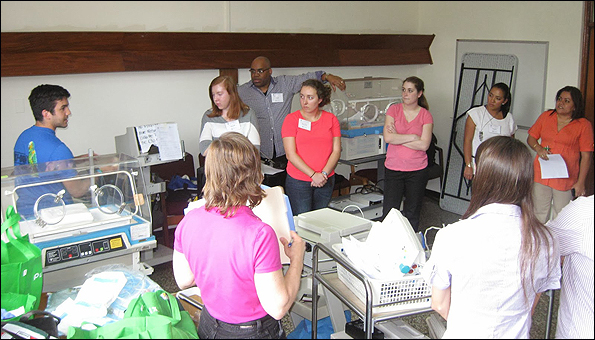
Two engineering professors and 12 undergraduates spent their spring break repairing medical equipment at hospitals in Guatemala as part of a biomedical engineering service learning course.
The team – students in BME 290 – arrived in Guatemala City March 1 and would travel to Antigua during their week’s stay. In all, they would work at four hospitals and join engineering students from Universidad del Valle in Guatemala City for a mini-conference.
 This was the fourth trip to Guatemala for Associate Professor Cynthia Paschal, who teaches the service learning course. Joining her was Matthew Walker III, associate professor of the practice of biomedical engineering. Under their direction and help, students repaired or tested a variety instruments ranging from essential operating room devices such as electrosurgical units and electrocardiogram (ECG) machines and patient monitors.
This was the fourth trip to Guatemala for Associate Professor Cynthia Paschal, who teaches the service learning course. Joining her was Matthew Walker III, associate professor of the practice of biomedical engineering. Under their direction and help, students repaired or tested a variety instruments ranging from essential operating room devices such as electrosurgical units and electrocardiogram (ECG) machines and patient monitors.
“It was a rich trip. It helped me to redefine my notion of needs assessment in innovation and helped me to realize that sympathy is no substitute for service,” said Professor Walker.
The student team members were Anna Arango, Sara Bowman, Nate Braman, Jake Bumpus, Casey Fitzgerald, Ally Garcia, Chris Gross, Mary Kate Hardy, Orlando Hoilet, Miranda Kunz, Daniel Pereira and Michael Schultis.
Their first stop was Moore Pediatric Surgery Center, the medical program of Franklin, Tenn.-based Shalom Foundation. MPSC hosts medical groups and surgical teams from around the world. The 12,000-square-foot facility offers operating rooms, four pre-op beds, 21 recovery beds and a pharmacy to serve children from across Guatemala.
At the pediatric facility the students got immediately to work testing anesthesia-system monitors for use in measuring ECG, temperature and blood pressure, and testing the functionality of a recently donated electrosurgical unit (ESU).
“Surgeons and workers coming to MPSC will be able to see the detailed notes and instructions our group members left behind, read the manuals, and use the new cables and parts we brought from Nashville,” said Professor Paschal.
The next stop was La Hospital de Juan Pablo II, a pediatric hospital that offers nearly all types of care, with specialists ranging from physical therapists to orthodontists. There students brought back into good working order two infant incubators, two light microscopes, a patient monitor, and several pulse oximeters. They tested two ventilators that had not been in use for almost three years. They also repaired and tested ECG machines, verified the function of several more patient monitors, and tackled a defibrillator and a very old ultrasound unit.
At Universidad del Valle, Vanderbilt and Guatemalan students exchanged presentations of their research and design projects. Casey Fitgerald, Orlando Hoilett and Nate Braman presented to some of the school’s undergraduate electrical engineering students. Two students from Universidad del Valle also presented their research.
In Antigua the team worked at Hospital Nacional Pedro de Bethancourt and Obras Sociales del Hermano Pedro.
At Pedro Betancourt, a public hospital, students tested and repaired an infant warmer, digging down to find and fix a board-level problem, and tested or repaired additional warmers and incubators, many monitors, a cervix cryotherapy device, pulse oximetry units, and more. They fixed an infant monitor, and worked with the hospital staff to teach them in detail how to operate the monitor.
Hermano Pedro, a private charity hospital, serves patients in a wide variety of specialties, emphasizing vital surgeries but also incorporating several extended care areas.
“A particularly heart-warming section of the tour was our visit to the pediatric nutritional recuperation center. Here, infants and young children are treated for malnourishment and given the chance to gain the strength needed to undergo procedures such as cleft palette surgeries,” said said bloggers Bumpus and Pereira.
The students provided the surgery unit with new electrocardiogram cables and recommendations on parts for their ventilation unit. The team worked a full day on surgical drills and saws, an electric cast cutter, and surgical light sources. At the end of the day, each member of the team was presented with a ‘diploma’ of appreciation for their work at Hermano Pedro.
“It was an excellent opportunity to add service and social responsibility to the ambitions of the students,” Professor Walker said.
One special moment reflected so many others during their trip, the students said.
After the team’s final summary report to a few of the hospital staff members at pediatric hospital Juan Pablo II, Lorena Sóto, one of the hospital directors, was brought to tears as she expressed her gratitude to the visiting students and faculty members.
“Queremos que ustedes sepan que Guatemala siempre sera una pequeña parte del mundo donde simpre estarán bienvenidos,” she said.
Translated: “We want you to know that Guatemala will always be a small part of the world where you are always welcome.”